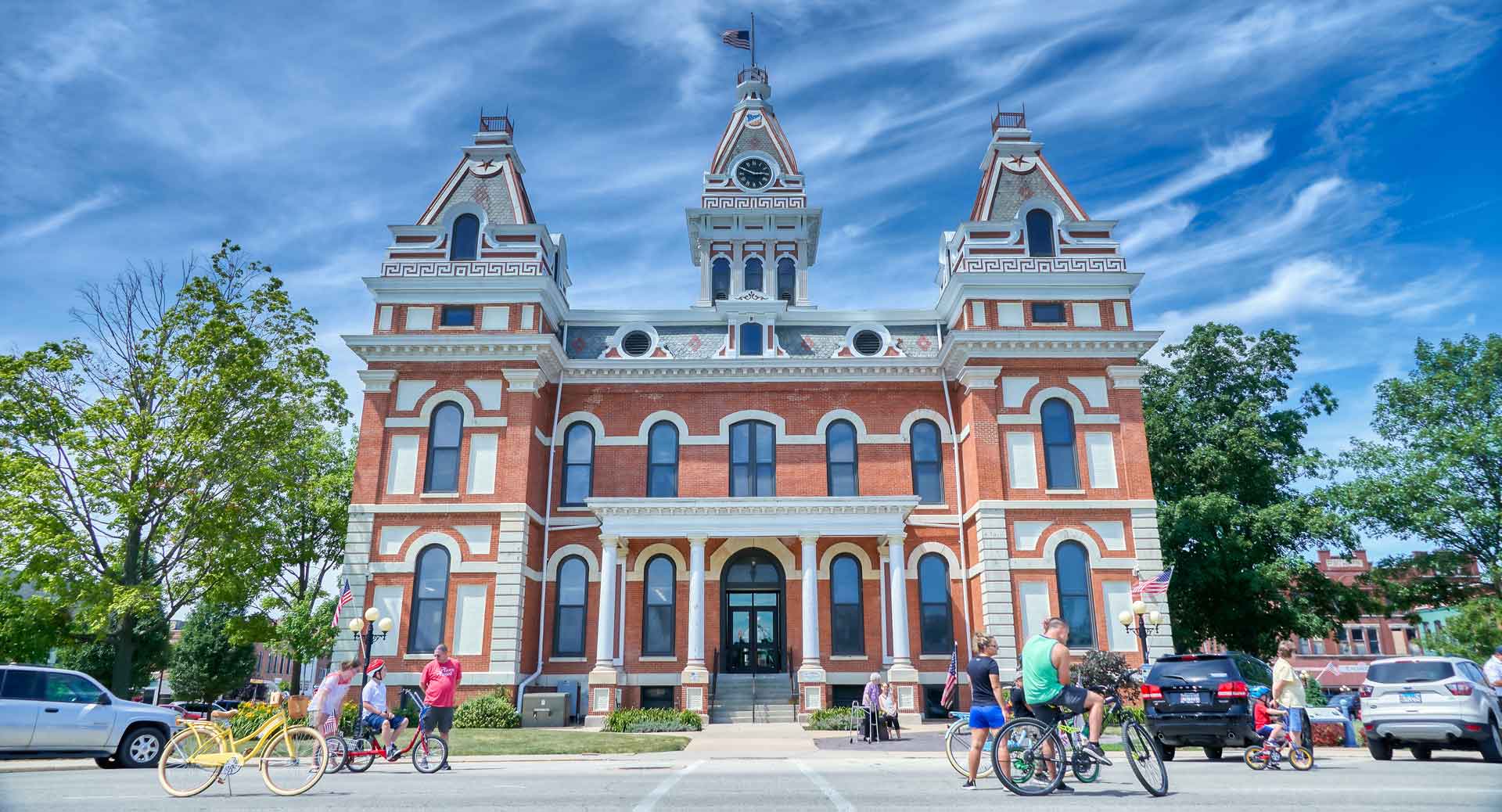
Prehistory
The Ancient Wilderness
The land that is today Livingston County sits on the moving continental plates of the Earth. In fact, it was south of the equator twice! During these times, the land was covered with tropical forests, which over the millennia formed coal deposits. The Mazon Creek fossils found here are world famous. Some of them are found nowhere else in the world. Some ancient life represented are ferns, insects, shrimp, jellyfish, and fish scales, all fossilized in rock 200-300 million years before the dawn of the dinosaurs.


More than 260 million years ago, a shallow ocean covered the area, forming layers of limestone from the calcium carbonate (limestone) shells of abundant snails, clams, and other sea life. Fossils of trilobites, mollusks, sponges, corals, and crinoids can be found in the local laminar limestone deposits. Shark teeth and starfish have also been discovered here. An amateur paleontologist from Eyler, just east of Pontiac, found two new fossil crinoid species in Wagner Quarry south of Pontiac. Her husband, also a crinoid expert, named one of the new species Pontiacensis, and the other Christinae after his wife.
Through the Ice Age, there was a mile-high block of ice atop the landscape. When it melted, Lake Ancona formed with a clean sand bottom. It eventually drained and Lake Pontiac was formed. As the climate became drier, Ice Age megafauna moved in. Local discoveries such as the tusk and tooth from a wooly mammoth are on display here today, along with a 50-pound copper nugget transplanted by the ice from the Mesabi Range iron ore area of northern Minnesota. Buffalo (American bison) covered the area during the Pleistocene Era (1 million to 10,000 years ago), and again 500-300 years ago only to finally disappear in the early 1800s.
Bison bones were found here in 2011 along the banks of the Vermilion River. They were only the third discovery of bison bones east of the Mississippi River from the Holocene Era (10,000 to 500 years ago), indicating only sparse and perhaps intermittent distribution of bison in this area. The other two Holocene discoveries were near Ottawa in a silica quarry, and in Mapleton (south of Peoria) where the mouth of a tributary stream emptied bison carcasses into the Illinois River.


The Dawn of Man in Livingston County
The first humans arrived 11,000-12,000 years ago. Only seven of their early spear points have been found, which they lost hunting the large Ice Age mammals. The Archaic Period peoples (9,000-4,000 years ago) were wandering hunter groups following game. Living in small groups, they roamed in search of food, camping several days to several weeks before moving on. They produced “points” commonly found along creeks and out on the prairie. These points were made from flint and chert, a form of metamorphosed limestone, deposits of which are rare in this area. This material was a highly traded item here. Some of their weapons and tools also include copper spear points; a 6-inch copper point was found in Sunbury Township. The Archaic peoples found rare copper nuggets dropped here by retreating glaciers to hammer out into tools and weapons. One of the most unique tools from this period is called the banner stone. These pieces of stone were of varied shapes with a longitudinal hole drilled in the center. They were slid onto a throwing stick called an at-lat’l. This extra weight and the extended leverage of the throwing stick enabled a hunter to throw a spear at a much higher speed, thus improving the chance of bringing down their prey.
The Woodland Period (4,000-1,400 years ago) saw more advanced cultures of settled groups in villages with gardens of sunflowers, squash, pumpkins, and beans to supplement hunting for game. Trade routes to Florida, Michigan, North Dakota and other far-away states were established for obtaining scarce items such as suitable stone for tools/weapons, copper for axes, and mica from Carolina for mixing with clay for stronger pottery. Workable stone from neighboring states like Indiana, obsidian (lava glass) from Wyoming, and copper from Minnesota and Wisconsin are evidence of that trading. Pottery first appeared in North America 3,000 years ago. That crude, early pottery is found here. Other finds include bear teeth and elk antlers — both species having disappeared from the area landscape long ago.
John McGregor, a Pontiac native who became the Director of the Illinois State Museum, found a blade he determined was made by the same person who made the Mackinaw Cache blades found in Tazewell County, a group of blades widely recognized as the finest examples of “chipped” stone ever found in North America. He was involved in many of the early archaeological efforts in the state. He directed the Washburn excavation of a mass burial near a creek that contained four pits with approximately 200 individuals each!

The Rise of a Culture
The Mississippian Period — 1,400-600 years ago — saw an even higher level of culture develop in North America. Instead of isolated sustenance gardeners and gatherers, corn and maize was more widely introduced, planted in larger tracts, and remains the dominant driver of Livingston County’s culture and economy. Two 11-inch flint hoes were found at two different locations along Rooks Creek as well as a cache of 26 hoes south of Pontiac. Simpler hoes from this time are found throughout the area. Use of these hoes marked the beginning of agriculture as we know it here today. The Mississippian people used corn as their main community resource rather than just another private family garden staple. Cahokia points are found here named after the Cahokia Mounds near Collinsville, home the largest prehistoric earthen structure in the Americas, Monk’s Mound. Larger at its base than Egypt’s Great Pyramid, Monk‘s Mound was the home of the king/god of what was at the time the largest city in the Americas. A copper falcon headdress piece was found at the mouth of the Vermilion River near Ottawa. Area peoples used the river as their highway for trade and cultural exchanges. A smoking pipe in the shape of a fish head and one of a bird’s head are examples of other artifacts from this period, found at opposite ends of the county.
Nearly all information we have of the prehistoric native human inhabitants of the area comes from discoveries of what they left behind — burials, tools and weapons, buried campsites and villages, and earthen works like Monk’s Mound. Burial mounds were common in the area; some were located off Billet Road just east of Pontiac on the river, the former site of the American Legion Billet building. The building is now a private home with an original fireplace that still contains axes and other artifacts from the area.
The mounds are gone now, as are most others that were in the county. In the early 20th century, a banker named Payne from Springfield excavated the Billet Road mounds and stripped them of all their manmade items and the story they could have told. A mound north of Fairbury along the river was excavated while digging a basement for a house. It contained one individual and burial goods.
Unlike their counterparts who went on south to settle Central and South America, North American natives produced no written language. Other than petroglyphs (picture art) that depicted events, surreal imagery, and early art, no translatable written record was left behind. Names of individuals, their tribal names, battles, migrations, food issues, weather… None of this direct information is known. Not until the onset of European migration westward from the east coast did any historical records appear to gain insight into the first 12,000 years of human history in Livingston County. More than 600 generations of Native Americans have called the area home since the last glacier melted 12,000 years ago. Families of European descent have lived here for 10 generations or less.
